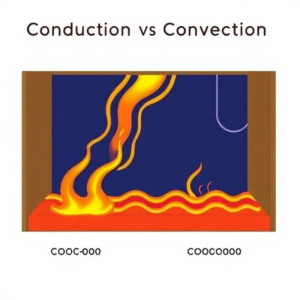Both conduction and convection are methods of heat transfer, which means they are ways heat moves from one place to another. However, they work in different ways, and they happen in different situations.
1. Conduction
Conduction is the transfer of heat through a solid or between solids that are in direct contact with each other. The heat moves from the hot part to the cold part by direct contact of particles.

How it Works:
- Particles in the material (like atoms or molecules) are always in motion, even in solids.
- When one part of a solid is heated (like a metal spoon on a hot stove), the particles in that part start moving faster.
- These faster-moving particles collide with slower-moving particles next to them and transfer some of their energy.
- This process continues from one particle to the next, so heat moves from the hot part of the material to the cooler part.
Example of Conduction:
- Touching a metal spoon that has been sitting in hot water. The heat from the hot water makes the spoon heat up, and then you feel it with your hand because the heat has conducted through the spoon to the handle.
- A pan on a stove: The burner heats up the bottom of the pan, and the heat moves through the metal of the pan to cook the food inside.
Key Points About Conduction:
- Happens only in solids (like metal, wood, or stone).
- The heat moves from hotter to cooler parts.
- Good conductors of heat include metals like copper and aluminum. Poor conductors are things like wood and plastic.
2. Convection
Convection is the transfer of heat through liquids or gases (fluids). Unlike conduction, which works in solids, convection happens because the fluid moves itself.
How it Works:
- In a fluid, when the particles are heated, they move faster and spread out, becoming less dense (lighter).
- The less dense, warmer fluid then rises, while the cooler, denser fluid sinks.
- This creates a convection current, where warm fluid rises, cools down, and sinks again, creating a circular flow of heat through the fluid.
Example of Convection:
- Boiling water in a pot: When you heat water on the stove, the water at the bottom heats up first, becomes less dense, and rises. The cooler water at the top then sinks to take its place. This creates a circulation of water, which helps cook the food more evenly.
- The atmosphere: Warm air rises because it’s lighter (less dense), and cooler air sinks. This movement of air is a type of convection that helps drive weather patterns like wind and thunderstorms.
Key Points About Convection:
- Happens in liquids and gases (fluids).
- The heat moves through the fluid by the movement of the fluid itself (not by direct contact like in conduction).
- The warm parts rise, and the cool parts sink, creating a convection current.
Main Differences:
| Feature | Conduction | Convection |
|---|---|---|
| What it occurs in | Solids (metals, wood, etc.) | Liquids and gases (fluids) |
| How heat moves | Heat moves through particle-to-particle contact | Heat moves through fluid flow (rising and sinking) |
| Example | Metal spoon heating in hot water | Boiling water or warm air rising |
| Good conductors | Metals like copper, aluminum | Less specific, but depends on the fluid |
| Main mechanism | Energy transfer through direct contact | Fluid circulation (convection currents) |
To Wrap It Up:
- Conduction happens when heat moves through a solid by particles touching each other and passing on the heat (like a spoon getting hot in a pot).
- Convection happens when heat moves through liquids or gases, creating currents as warm fluid rises and cool fluid sinks (like boiling water or the movement of air in the atmosphere).
Tags: aluminum, atmospheric convection, boiling water, Conduction, conduction examples, conduction in solids, conduction mechanism., Convection, convection currents, convection examples, convection in air, convection in water, convection mechanism, convection vs conduction, cool fluid sinks, copper, direct contact heat transfer, energy transfer, fluid circulation, fluid flow, gases, heat conduction process, heat flow mechanisms, heat movement, heat transfer, heat transfer in fluids, heat transfer in metals, heat transfer methods, liquids, metal spoon heating, particle-to-particle contact, plastic, poor conductors, solids, temperature difference, thermal conduction, thermal energy, warm fluid rises, weather patterns, wood


